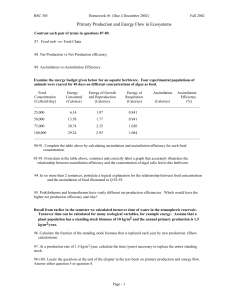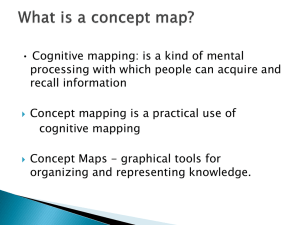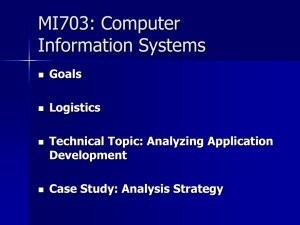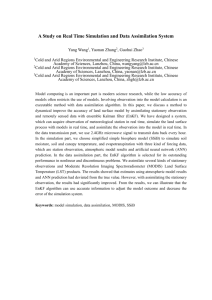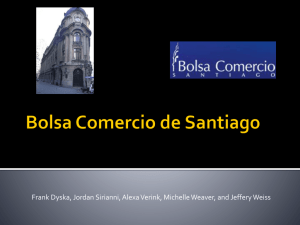adoqa conesud
advertisement
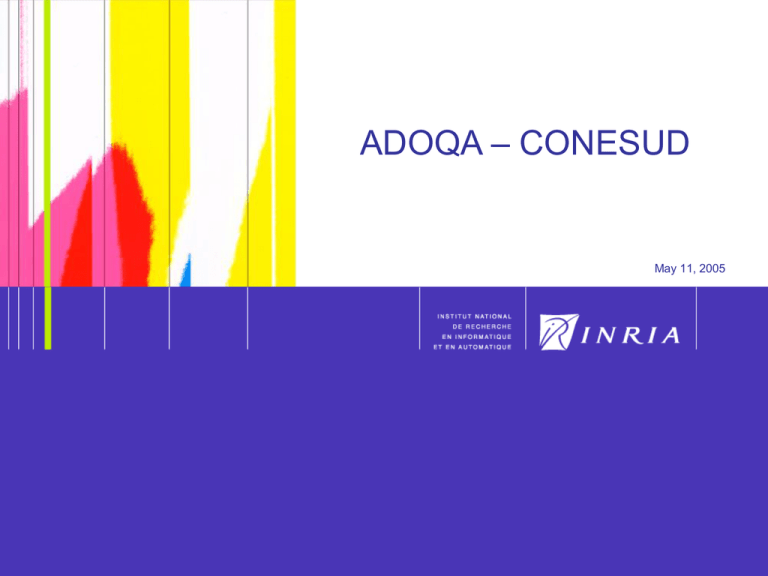
1 ADOQA – CONESUD May 11, 2005 2 ADOQA CONESUD Assimilation de données pour la qualité de l’air dans le Cône Sud Data assimilation for air quality in South Cone INRIA/ENPC CLIME team (F) University of Cordoba (Arg) Centro de Modelamiento Matemático (CMM, Chile) Dirección Meteorológica de Chile (DMC, Chilean Weather Office) Comisión Nacional de Energía Nuclear (CNEA, National commission for nuclear energy, Arg) 3 Context of collaborations With Argentina •G.A. Torres, former ERCIM post-doctoral fellow: air quality forecast, data assimilation, application to Berlin, in cooperation with Fraunhofer-FIRST. •Submission of an EcoSud proposal: air quality forecast and data assimilation, application to the city of Cordoba (rejected). •Letter of Intent for participation in the framework of the Fr/Arg technical cooperation agreement. With Chile •INRIA-CONYCIT project "AIRPOL": retroplume techniques for inverse modelling of arsenic sources in the Santiago basin. The South American partners participate to a research network for the development and improvement of emission inventories by means of inverse modelling techniques (Inter American Institute for Global Change). 4 ADOQA – CONESUD Objective To strenghten the cooperation in the areas of air quality modelling, data assimilation and forecast between five teams: •INRIA/ENPC CLIME team (F) •CMM and DMC (Chile) •University of Cordoba and CNEA (Argentina) Application to regional and mesoscale air quality modelling in South America, focus on large urban centers and megacities. 5 ADOQA – CONESUD work basis ADOQA-CONESUD builds on the expertise gathered by the partners to construct a numerical platform for air quality forecast. •Meteorological modelling: use of the meteorological solver MM5 (mesoscale meteorological solver, developed by University of Pennsylvannia). •Air quality modelling : Polair3D (developed by ENPC). •Data assimilation techniques: ensemble Kalman Filter. All components have been integrated during the post-doctoral work of G.A. Torres for application to the city of Berlin. 6 Air quality forecast with Polair3D -Polair3D is a 3D Chemistry-Transport Model (CTM) developed by ENPC. -Part of a full air quality modelling system Polyphemus, freely available. http://www.enpc.fr/cerea/polyphemus -Validated in different experiments: •regional (Paris, Lille, Marseille, Berlin), •continental (ozone forecast in Europe). -Used at CMM for arsenic inverse modelling. -Capable of variational (4DVAR) and sequential (EnKF) data assimilation. 7 Polair3D input data needs Most important data sets are: -Meteorological fields, required for the transport and deposition of pollutants, for photolysis computations: computed from global analyses (NCEP, ECMWF) and/or from outputs of mesoscale meteorological solver (MM5): this can be particularly difficult in complex terrain (e.g. Santiago basin). -Emission inventory: difficult to collect, since emissions have various sources, some of which difficult to assess: industry, households, traffic, biogenic emissions. -Background and initial conditions: provided by nesting regional runs with continental runs. 8 Polair3D: Ozone forecast at European scale Polair3D is routinely used for ozone forecast at European scale. It uses meteorological fields provided by ECMWF and EMEP emission inventory. 9 Polair3D: regional modelling, Berlin Work of G.A. Torres Polair3D uses MM5 meteorological fields and local emission inventory. Comparison between measurement at a ground station (red), Polair3d (blue). 10 Polair3D: inverse modelling of As, Santiago Reconstruction of As emissions (red areas) around Santiago. Obtained from 165 daily measurements made in Santiago (triangles). Most important source, Caletones, well detected, with 42kg/h instead of declared 50. Black dots in NW: undetected small sources (meteorological conditions, measurement & modelling noise). Data assimilation by Ensemble Kalman Filter (EnKF) -Air quality forecast requires an accurate knowledge of forcing by meteorology and emissions. -This knowledge can be improved by comparing forecasted to measured concentrations. -EnKF is a sequential data assimilation technique: each time a measured concentration is available, forcing terms are corrected in order to minimise the difference between forecast and observations. -Propagation of model errors is performed by Monte-Carlo techniques: several forward runs are performed in parallel with perturbated inputs, to provide the require error statistics. 11 12 Data assimilation: EnKF Example of ozone measurement assimilation, application to Paris. Forward run without assimilation (yellow curve). Assimilated measurement (green dots). Analysis after assimilation (white curve). 13 ADOQA – CONESUD work tasks -to develop and validate a numerical platform suited for operational use, for air quality forecast over Argentina and Chile, particularly for large urban centres and megacities: Santiago, Buenos Aires and Cordoba. -Driving meteorological fields calculated using MM5, already at use at DMC and University of Cordoba. -Pollutant dispersion and chemistry modelled by Polair3D, developed by ENPC, already at used by various teams. -Ensemble Kalman (EnKF) data assimilation techniques, will be used to ingest measured data within the system. 14 ADOQA – CONESUD milestones 1. Collecting and evaluating the required data (emission, measurements). 2. Adapting the numerical platform MM5/Polair3D/EnKF to the specific cases. 3. Validating by comparison to observations, for representative weather conditions. 4. Workshop on air quality modelling, in Cordoba, 2006. We try to fulfill 1 & 2 in 2005. 15 ADOQA – CONESUD resources •France to Chile: available from AIRPOL (INRIA/CONYCIT): one researcher, two weeks in Santiago. We are looking for support to a second researcher to come in Santiago. •Chile to France: available from AIRPOL: one researcher, two weeks in Paris. We are looking for support to a second researcher. •France <-> Argentina: new proposal to be submitted (currently Letter of Intent, France-Argentina technical cooperation agreement). •Chile <-> Argentina: IAI research network, CONESUD. •Workshop organisation: support from CONESUD program.


